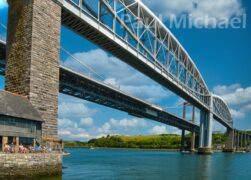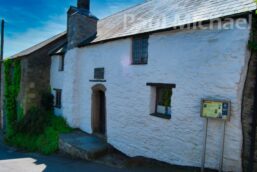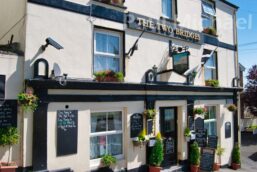Last Updated on 15th March 2023
Saltash is a major, bustling town and the gateway to Cornwall from the A38. It lies on the west bank of the River Tamar with Plymouth to the east.
A Town of Bridges
Road access is via the Tamar Bridge, opened in 1961 (formally in 1962), which replaced the original ferry. It is an impressive 335-metre suspension bridge. In more recent years, the bridge was widened by a cantilever road on either side of the original bridge. This fantastic feat of engineering was accomplished while the bridge remained open to road users.
By rail, Saltash and Cornwall are accessed via the Isambard Kingdom Brunel’s Royal Albert Bridge, which was opened in 1859. The people of Saltash are immensely proud of this bridge, and quite rightly so, It is an engineering marvel but was of course such a vital transport link to and from Cornwall. Saltash railway station is the first stop when coming into Cornwall.
Saltash was known as Essa in the Cornish language (essa also means ‘ash’ in Latin). Essa exists today as a ward in the SE corner of Saltash. Later, the word Salt was prefixed to local pronunciations of ‘ash’ for Essa. The salt makes reference to the tidal River Tamar. And so it came to be Saltash. Over the years the town has grown and now comprises the wards and suburbs of Latchbrook, Pilmere, Burraton, St Stephens and Forder. As such, it is the largest town in South East Cornwall with over 16,000 residents. By comparison, Bodmin has nearly 13,000 and Liskeard around 10,500 (2011 census).
There is plenty for the day-tripper to see and do in Saltash.
Saltash Riverside
Fore Street, Saltash’s centre, is on a fairly steep gradient that gets steeper when it merges with Lower Fore Street as it heads down under the two bridges to the riverside. Going down is easier than coming back up!
The riverside boasts fantastic views up and down the river and, along with the bridges, there are lots of opportunities for some great photos. A paved street runs north to south of the riverside for a nice walk. Reaching the site of the bridges, there are restaurants/cafes and the Union Inn. A little further along is Saltash Sailing Club. Ashtor is now a cafe but is an important historical building for Saltash.
There is a children’s play park and, last seen in this neck of the woods, is the sitting statue of Ann Glanville. Born in 1796, Ann is famed for rowing and championing in a 4-oared Pilot’s gig (a fast clinker-built traditional boat) with an all-women crew. Nowadays, her statue is famed for telling a story or two about Saltash – she’s a talking statue.
Historic Buildings
For the walk up the steep Albert Road, let’s take it in chunks and take a left along Culver Road to visit Mary Newman’s grade 2 listed cottage. Mary was Sir Francis Drake’s wife. The cottage has been preserved to be as it would have been back in the day.
A little further up Culver Road, by the Baptist Church, turn right to the rail station. The Two Bridges pub is at the end of the lane by the station’s refurbished Isambard House, each offering drinks, snacks and food.
Up Albert Road for a few metres, turn right on Station Road to see Saltash Guildhall and, also, the Church of St Nicholas and St Faith. The church is old and Grade 1 listed with parts of it dated to the Norman era. There is a convenient car park here as well if arriving by road. Turn left up Lower Fore Street for the Railway Hotel, another popular pub.
A recent addition to the town is its Celtic Cross, known also as the Cornish Cross. A 20-metre-tall structure, erected in 2013 by sculptor Simon Thomas to celebrate Cornish culture. It can be reached by a walkway under Tamar Bridge to the small park that is the site of the Cross.
Town Centre
Just a little further up the hill is the main shopping centre. It starts a Lower Fore Street. Across the road from the Guildhall is Saltash Heritage Centre and H Eliott’s Store, a preserved time capsule of an abandoned shop from many years ago.
As the road merges into Fore Street, look to the left to see a walkway entrance to Keast Mews, comprising a number of small shops and a cafe.
The town centre continues up Fore Street as the main shopping area. The shops are a mix of grocery, clothing, gifts, cafes, pubs, restaurants and other retail outlets. They are aimed more at residential living than tourists and visitors, but are well worth a visit or look in the windows.
There are two car parks along Fore Street – one near the bottom which is at the back of Keast Mews, and the other near the top of the street.
Around Saltash
Trematon Castle is an 11th-century structure and a fine example of a motte and bailey design with a keep on a raised hill. It’s a prominent building in the area. The ward of Burraton and Trematon were the first settlements in the area.
SE Cornwall is a wonderful corner of Cornwall for visiting and taking a holiday or short break. There is an abundance of things to do and see. Fowey, Looe Charleston, Lostwithiel, Polperro, Kingsand, Cawsand, St Germans, Mount Edgecumbe, Plymouth and more. All are within easy reach by car. Some can be reached by train, public transport and even river ferries.
Take a look at my articles relating to SE Cornwall for walks in the area. There are plenty.
The town is on the A38 and mainline train routes into Cornwall. Aside from all that SE Cornwall offers the visitor, there is more of Cornwall along the way.
Here is a list of hotels and holiday properties in the Saltash area for a great break from it all.
[products limit=”16″ columns=”4″ category=”SE Cornwall” orderby=”date” order=”DESC”]









